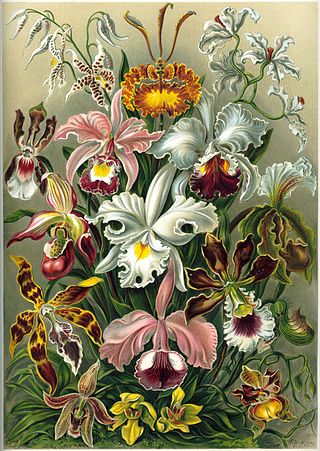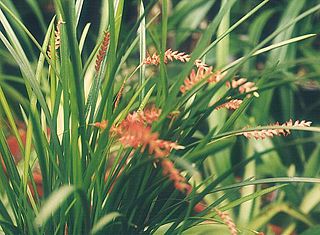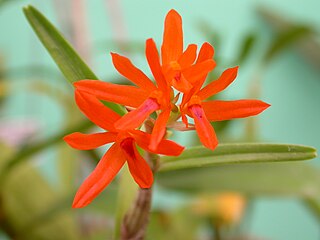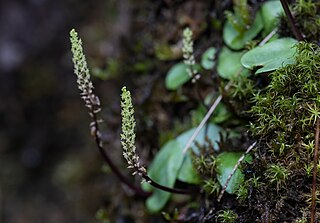
Cymbidium, commonly known as boat orchids, is a genus of evergreen flowering plants in the orchid family Orchidaceae. Orchids in this genus are epiphytic, lithophytic, terrestrial or rarely leafless saprophytic herbs usually with pseudobulbs. There are usually between three and twelve leaves arranged in two ranks on each pseudobulb or shoot and lasting for several years. From one to a large number of flowers are arranged on an unbranched flowering stem arising from the base of the pseudobulb. The sepals and petals are all free from and similar to each other. The labellum is significantly different from the other petals and the sepals and has three lobes. There are about fifty-five species and sixteen further natural hybrids occurring in the wild from tropical and subtropical Asia to Australia. Cymbidiums are well known in horticulture and many cultivars have been developed. The genome of Cymbidium mannii has been sequenced to study epiphytism and crassulacean acid metabolism.

The taxonomy of the Orchidaceae (orchid family) has evolved slowly during the last 250 years, starting with Carl Linnaeus who in 1753 recognized eight genera. De Jussieu recognized the Orchidaceae as a separate family in his Genera Plantarum in 1789. Olof Swartz recognized 25 genera in 1800. Louis Claude Richard provided us in 1817 with the descriptive terminology of the orchids. (See External links below). The next step was taken in 1830-1840 by John Lindley, who recognized four subfamilies. He is generally recognized as the father of orchid taxonomy. The next important step was taken by George Bentham with a new classification, recognizing subtribes for the first time. This classification was first presented in a paper that Bentham read to the Royal Society in 1881. Then it was published in 1883 in the final volume of Genera Plantarum. The next great contributors were Pfitzer (1887), Schlechter (1926), Mansfeld (1937), Dressler and Dodson (1960), Garay (1960, 1972), Vermeulen (1966), again Dressler (1981). and Burns-Balogh and Funk (1986). Dressler's 1993 book had considerable influence on later work.

Heinrich Gustav Reichenbach was a botanist and the foremost German orchidologist of the 19th century. His father Heinrich Gottlieb Ludwig Reichenbach was also a well-known botanist.

Dendrochilum was a genus of epiphytic, lithophytic and a few terrestrial flowering plants in the orchid family (Orchidaceae). It is now considered to be a synonym of Coelogyne Lindl. The name of this genus was derived from Ancient Greek words dendron ("tree"), and either cheilos ("lip") or chilos, alluding to either the flowers' large lip or to their epiphytic growth. These orchids are popular among fans of non-traditional orchid curiosities.

Bifrenaria, abbreviated Bif. in horticultural trade, is a genus of plants in family Orchidaceae. It contains 20 species found in Panama, Trinidad and South America. There are no known uses for them, but their abundant, and at first glance artificial, flowers, make them favorites of orchid growers.
Friedrich Wilhelm Ludwig Kraenzlin was a botanist associated with the Natural History Museum (BM).

Scaphyglottis is a genus of orchids native to Mexico, Central America, northern South America and parts of the Caribbean. The current concept of this genus is the result of combining several genera which have been described at various times. The concept is characterized by the growth habit: not only are new pseudobulbs added at the base of the old ones, but new pseudobulbs also grow at the apices of the old ones. Many species are quite similar and difficult to distinguish, but some are clearly distinct. A few have showy colors. The genus comprises nearly 70 species.

Dendrobium atroviolaceum is a species of epiphytic orchid endemic to eastern New Guinea. It was described by English botanist Robert Allen Rolfe in 1890 based on a specimen collected by James Veitch & Sons.

Polystachya subdiphylla is a species of orchid native to Tanzania.
Bulbophyllum abbreviatum is a species of orchid in the genus Bulbophyllum discovered in Madagascar and originally described by German botanist Rudolf Schlechter, from material collected by French botanist H. Perrier de la Bâthie in February 1912, which is now kept in the Muséum National d'Histoire Naturelle in Paris.
Hanna Bogna Margońska, born 1968 is a Polish botanist known for her work on orchids.
Triceratorhynchus is a genus of flowering plants of the orchid family, Orchidaceae. It is native to central Africa: Cameroon, Rwanda, Burundi, Uganda, and Kenya.

Polystachya neobenthamia is a species of flowering plants from the orchid family, Orchidaceae. It is terrestrial, lithophilic and grows among leaf litter and other detritus on rock faces. It is endemic to Tanzania.

Oberonioides is a genus of orchids native to China and Thailand. Only two species are known:
Oeceoclades latifolia is a terrestrial orchid species in the genus Oeceoclades that is endemic to São Tomé Island. It was first described by the British botanist Robert Allen Rolfe in 1891 as Eulophia latifolia, then moved to the genus Eulophidium by V.S. Summerhayes in 1957 and again moved to the genus Oeceoclades in 1976 by Leslie Andrew Garay and Peter Taylor. Garay and Taylor noted that O. latifolia is similar in vegetative morphology to O. atrovirens but the floral structure is more similar to O. ugandae. The lateral veins on the labellum are fringed with small hairs, a characteristic that is shared with O. pandurata, O. seychellarum, and O. lanceata.
Oeceoclades seychellarum is a terrestrial orchid species in the genus Oeceoclades that was endemic to the island of Mahé in the Seychelles but is now considered to be extinct. Its sepals and petals are yellowish-white, while the labellum is white with some streaks. This species is only represented by the type specimen, collected in May 1902 from the Cascade Estate on the island of Mahé at an elevation of 900 feet (270 m) in what was then a mountain forest. The location from which the type specimen was collected is now degraded by human activity and invasive plants. Oeceoclades seychellarum was listed as being cultivated at the Royal Botanic Gardens, Kew in 1905, but not after that date.
Malaxis boninensis is a species of flowering plants in the family Orchidaceae, native to the Bonin Islands and the Volcano Islands, both belonging to Japan. It grows on the ground from pseudobulbs. It was first described by Gen-ichi Koidzumi in 1918, as Microstylis boninensis, and transferred to Malaxis by Kunio Nakajima in 1975.

Myrmecophila tibicinis is an orchid in the genus Myrmecophila. A common name for the species is the trumpet player's Schomburgkia. It was first described by Bateman in 1838, as Epidendrum tibicinis, and assigned to the genus Myrmecophila by Rolfe in 1917.
Donald Frederick Blaxell, is an Australian botanist, botanical collector and taxonomist.












